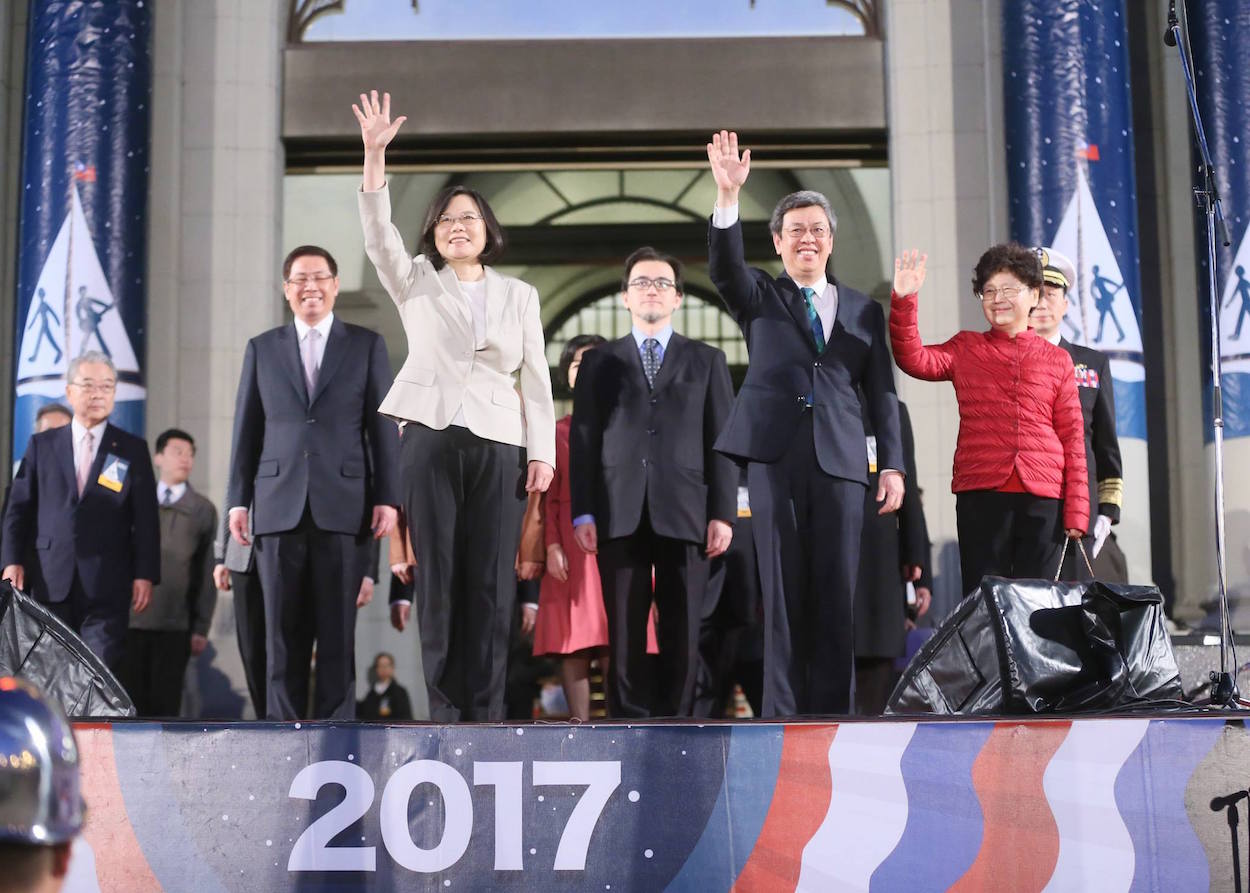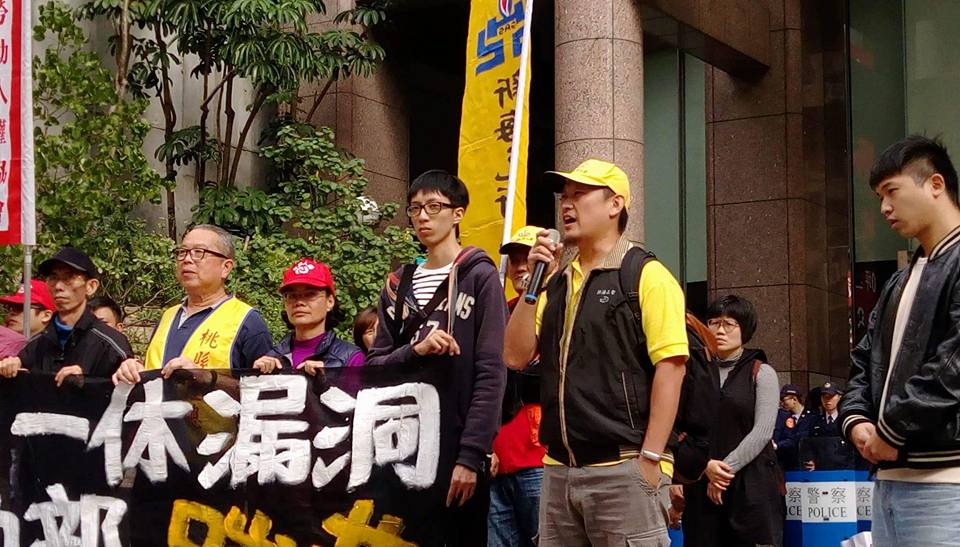by Brian Hioe
語言:
English
Photo Credit: Presidential Office
CONTINUED CONTROVERSY over labor reforms pressed into law by the Tsai administration not only illustrate the manifold problems with Taiwan’s workplace culture, but also to what extent the Tsai administration has miscalculated regarding the issue. Polling strongly suggests that a large factor behind the decline in approval ratings of the Tsai administration is dissatisfaction with the Tsai administration’s handling of labor policy, with ire directed not only against Tsai herself, but with Premier Lin Chuan, who has served the public face of labor reforms.
The Tsai administration decided to side with big business over organized labor in forcing cuts to seven out of nineteen public holidays and refusing to relent on the issue of giving workers not two set days off per week, but only one day off per week with one “flexible rest day” in which workers can still be made to work. This was a mistake by the Tsai administration, seeing as labor represents not simply one interest group in society which the Tsai administration could shrug off, but represents the whole of Taiwan’s working population.
 Photo credit: Presidential Office
Photo credit: Presidential Office
Namely, the Tsai administration previously indicated that it would be open to negotiating with protesting labor groups before the reactions of business leaders led to it sharply reverse course. This included a willingness to force labor reforms through committee in the Legislative Yuan by changing the site of the committee meeting and time of the meeting at the last minute, actions which have been protested as undemocratic. But either way, reactions against the Tsai administration from members of society would probably not have been so severe if the Tsai administration had stuck to a clear path from the beginning, rather than flip-flopping on the issue multiple times. In this light, the Tsai administration’s refusal to communicate its policies with society have only led to the perception that, concerning the issue, the Tsai administration is at best ineffectual and at worst hypocritical.
However, business and industry groups continue to protest the labor reforms that the administration passed nonetheless. The wide reaching nature of the labor reforms does, in fact, have a severe impact on industries which face an inability to remain fully staffed because of the reduction of the 84 hours per two weeks to 40 hours per week, or see a rise in labor costs because of additional overtime which needs to be paid to workers. Likewise, as a result of the “flexible rest day” not actually counting as a day off, but as so many hours of rest per week, given the peculiarities of some industries, TRA workers, other transportation workers, and workers in other vital industries to the running of the nation can actually be made to work more than they were before because of new labor policies.
 Photo credit: Lexcie/WikiMedia
Photo credit: Lexcie/WikiMedia
If the Tsai administration or business leaders have scoffed at the demands of labor groups as workers simply being needy, greedy, and demanding more than is feasible, their hypocrisy is all too clear in we see how business and industry groups continue to push for extracting further labor from workers even after the Tsai administration consented to their demands. We do well to remember a fundamental fact the Tsai administration has forgotten in its calculations—it is business leaders which represent a small, vested interest group that makes social demands disproportionate to their actual numbers, not organized labor. For all the talk of widespread reforms which the Tsai administration rode into power on, perhaps the Tsai administration’s view of social change remains deeply bound up with pleasing social elites above all other elements of society?
Moreover, the twisted nature of Taiwanese workplace culture is evident in that business groups’ solution to what is quite evidently a problem of understaffing is not to hire more workers, but in many cases to try and force workers to work overtime, and then accuse workers of greediness. Taiwanese workers already work some of the longest hours in the world, Taiwanese workers working the fourth longest working hours in the world, and Taiwanese workplace culture oftentimes excepts long overtime hours for no pay.
Some have phrased the problem as a conflict between economic success and workplace conditions, for example, in comparing Taiwan to South Korea and suggesting that South Korea’s economic successes are built on the long work hours of South Korean workers. Yet is the point for Taiwan to drive its citizens to work themselves to death, as observed in the social phenomenon of karoushi observed in all of the “East Asian Tigers”? Though best known as a Japanese phenomenon, karoushi, the phenomenon of overworking one’s self to death, is observed throughout all of the “East Asian Tiger” economies, which share not only similar economic models but also similar workplace cultures.
 Internet meme mocking Taiwanese workplace culture. Photo credit: 我在路上碰到藍島
Internet meme mocking Taiwanese workplace culture. Photo credit: 我在路上碰到藍島
Is this, then, the progressive vision of social welfare and national prosperity that the Tsai administration claimed it would realize during 2016 election campaigning? This is what the Tsai administration and other members of the Taiwanese government need to ask themselves. The Tsai administration campaigned claiming that it had heard the voice of Taiwan’s youth, who are may be unemployed or permanently live in an economically precarious status, experiencing lives very much unlike their parents, who grew up during the time of Taiwan’s rapid economic development and so accrued the social benefits of Taiwan’s economic miracle.
But one thinks that without fundamental reform of labor policy in Taiwan, it would be Taiwan’s young who suffer the most in the future. With a declining working population in coming decades as a result of a declining birthrate and growing elderly population, probably what will happen is that business leaders will simply try to extract more from the declining workforce of young people. Taiwanese workers, particularly young people, will simply made to work even harder. So much for the Tsai administration standing for the interests of young people then.
The Tsai administration currently claims that it will “Make Taiwan a tiger again,” as a solution to Taiwan’s economic woes. Politicians claiming that they will revive a period of economic prosperity that their country experienced decades in the past is nothing new in political rhetoric. Yet it is ironic to note that while today’s young people seem less well off than their parents were at a similar age, Taiwan’s economic miracle was built on the backs of Taiwan’s working class, something which went hand-in-hand with hash exploitation of Taiwanese labor. We might actually beware of viewing Taiwan’s economic miracle in rosy, nostalgic terms.
 Photo credit: Worker’s Struggle
Photo credit: Worker’s Struggle
But, while it is not only unable to realize this promise, perhaps the Tsai administration only intends to make such claims to justify harsher work conditions for Taiwanese workers. In the case of current labor reforms, the Tsai administration is already claiming that its actions have benefitted Taiwanese workers never mind that it specifically disregarded the will of Taiwanese workers to pass such reforms and the effects of such legislation in many cases have only had a detrimental effect on the lives of Taiwanese workers.
This may be a negative precedent for future backsliding by the Tsai administration, as justifying future backsliding by the Tsai administration to placate the demands of business, regardless of the effects upon labor. What, then, for the future of Taiwanese working society? And will the fundamental problems of Taiwanese workplace culture change?

